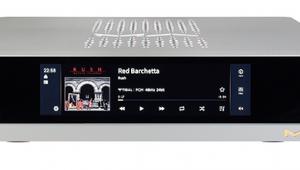Chord Electronics 2go/2yu Network Bridge

 The latest additions to Chord Electronics' range don't immediately give up the secrets of what they do – but dig deeper, and you'll find they're intriguing digital components
The latest additions to Chord Electronics' range don't immediately give up the secrets of what they do – but dig deeper, and you'll find they're intriguing digital components
There are times when one might think Kent-based Chord Electronics is being wilfully abstruse in its selection of model designations. After all, its flagship DAC is called DAVE [HFN Apr '16], and its pocket-sized DAC/player combination is the Mojo [HFN Jan '16] and Poly. Then there's the portable Hugo DAC/headphone amp, now in both Hugo 2 [HFN Aug '18] and less-portable Hugo TT (for 'tabletop') versions [HFN Dec '15], to which the company has now added two extra units, named 2go and 2yu.
Now, while the £995 2go can be bolted onto the £1800 Hugo 2, bringing to it both Ethernet and wireless streaming, plus memory card playback, in the same way that the Poly adds these facilities to the little Mojo, the £449 2yu is a rather different matter. It's designed to be used with the 2go, adding to the playback and streaming functionality a digital output interface with RCA/BNC electrical and Toslink optical sockets, plus a USB-A to which a suitable DAC can be connected.
In Your Pocket
In short, while the 2go is expressly built as a Hugo 2 add-on, the 2yu opens up the 2go's capabilities for use with other DACs. It's powered by the 2go's internal battery, the pair effectively putting a complete network audio transport in your pocket or, with the 2go's ability to accept up to 4TB of microSD storage via two slots, a complete portable music library/player. You can also use the 2yu alone, powered and fed data from your computer over USB, with pass through over coax/optical to conventional digital outputs.

If that's got you a shade baffled, you have my sympathy: even with the three immaculately-built components – Hugo 2, 2go and 2yu – before me, all resplendent in their machined-from-solid aluminium casework, with deeply-engraved model numbers and those familiar Chord ball-shaped controls, I still found myself forced back to the user guides.
Hello World
I also struggled a bit with the company's GoFigure app which is used to set up both Mojo/Poly and the 2go, and is greatly improved since first I encountered it. But once grasped, both these devices are a delight to use.
Whether the 2go is clipped onto the Hugo 2 as the Poly does to the Mojo, or used with the 2yu as a digital transport, it is able to connect to the outside world via 2.4GHz Wi-Fi and A2DP Bluetooth, as well as wired Ethernet via an RJ45 socket. It can then play online services including Qobuz, Tidal and Internet radio, as well as being a DLNA-compliant server/renderer, meaning it will play content on network storage and make files on inserted microSD storage visible to other players. It supports DoP and 'bitperfect audio', is AirPlay ready and can also function as a Roon endpoint.
All this is achieved using a proprietary streaming platform and a triple-core processor, along with a slightly gimmicky voice engine to give the user status updates. Otherwise, to control the 2go you'll need to resort to a third-party DLNA/UPnP client app. I used the excellent mConnect with good results. And it isn't just the Chord 2go streamer that's crammed with in-house technology.
The 2yu may look like a simple USB in/digital out interface, but it has a hugely powerful processor up its sleeve, and offers an integrated sample rate converter, plus a jitter-suppressing PLL.
Dock To Rock
Used together, the 2go and 2yu can pass data at up to 768kHz/32-bit and DSD256 to a suitable DAC via USB, up to 384kHz/32-bit and DSD64 via the coax and BNC digital outs, and up to 192kHz/24-bit via optical. Meanwhile, docking the 2go to the Hugo 2 is a matter of locating the two Micro USB plugs and sockets (charging and audio) and then locking the components together via a couple of Allen bolts. This proved a little tricky at first, but after some gentle trial and error jiggling I managed to get the two firmly joined.


















































